Entering the Virtual Cipher

For the last seven years I’ve been following the spread of hip hop culture in Egypt. When I visit Cairo, I always look forward to hearing new songs at my friends’ rap shows. And the big annual breakdance battles never fail to impress with new b-boy talent. But usually, I find myself gravitating towards the more informal hip hop “performances” that happen off stage. It’s from these that I learn the most.
In August 2014, a group of young Egyptians began gathering each week on Cairo’s sidewalks to trade rap lyrics. They called their weekly event the Mafshakha cipher and convened on Thursday nights, the beginning of the weekend in Egypt.[1] These evenings often saw more than fifty rappers in attendance who “ciphered” together, each rapper showcasing his lyrical abilities for a minute or two before letting the next rapper in the circle perform.[2]
The Mafshakha cipher fizzled out in November 2015, about 15 months after its inception. Egypt’s strict laws for public protests make any street gatherings suspect to authorities. Unsurprisingly, the Mafshakha’s large meetings attracted several encounters with local police. The group’s dissolution also coincided with a highly anticipated cipher battle, one that actually never happened—the Mafshakha’s founder, Afreet, retreated from the rap duel just before his opponent arrived, provoking the ire of many Egyptian rap fans.[3] While Mafshkaha rappers went on rapping, the Thursday night gatherings lurched to a halt.

Mafshakha gathering in Heliopolis, Cairo
Since then, Egyptian rappers have hosted a handful of cipher battles on public streets but nothing with the regularity or popular support of the Mafshakha.[4] With public space heavily restricted, where do Egyptian youth turn to practice what Erving Goffman calls their “vaunted selves” (1959:206)? What solutions do new spaces offer to old problems? And how are these creative spaces organized? Because even when informal institutions like the Mafshakha promote themselves as free, democratic, nonhierarchical, any first-time visitor will quickly discern a code of norms, a scale of authority, to which he’s acutely unaccustomed. My post tries to probe some of these questions.
Mafshakha gathering
The Flying 16 Challenge
A month after the Mafshakha’s demise, Alexandrian rapper Abdelrahim Adham inaugurated the Flying 16 Challenge (tahaddi sit‘ashar ‘at-tayir), which became, in effect, an online rap cipher.[5] The Flying 16 Challenge gained immediate popularity not just with rappers in Egypt but those throughout the Arab world. While video contributions dwindled considerably after the first two months, new videos are still being posted. The Flying 16’s Facebook page outlined its objectives in the following:
The idea came from the Gorilla Clan (Egyptian rap group) and gets help from rappers in Alexandria, as well as other provinces, to support Egyptian rap. It's not a challenge so much as it is a movement to revitalize... The idea is that each rapper has his own unique musical style that people know and like. So why don't we hear them rap over new music? Or put a better way, let’s hear specific verses over famous instrumentals instead of the beats that they usually rap over. (Author’s translation from the Arabic[6])
How exactly would rappers carry out this “revitalization” of Egyptian rap? The Flying 16’s Facebook page posted detailed instructions for rappers wishing to participate. The format emulated that of the Ice Bucket Challenge, a 2014 internet craze nominally aimed at raising awareness for ALS in the United States (participants filmed themselves dumping ice on their heads, then nominated several others to do the same, who nominated other friends, and so on). In the Flying 16 Challenge, rappers film themselves performing 16 bars (measures) of lyrics over an unfamiliar hip hop instrumental. They then challenge other rappers to follow suit. The challenger usually specifies the new beat each nominee should use. In this way, the nominee is obliged to demonstrate competency over music that may be particularly fast, slow, or outside his preferred style.
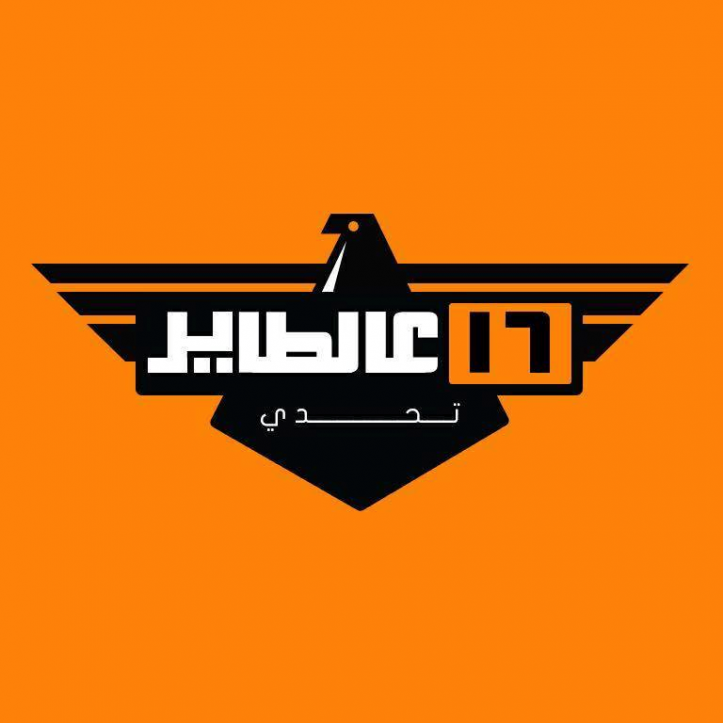
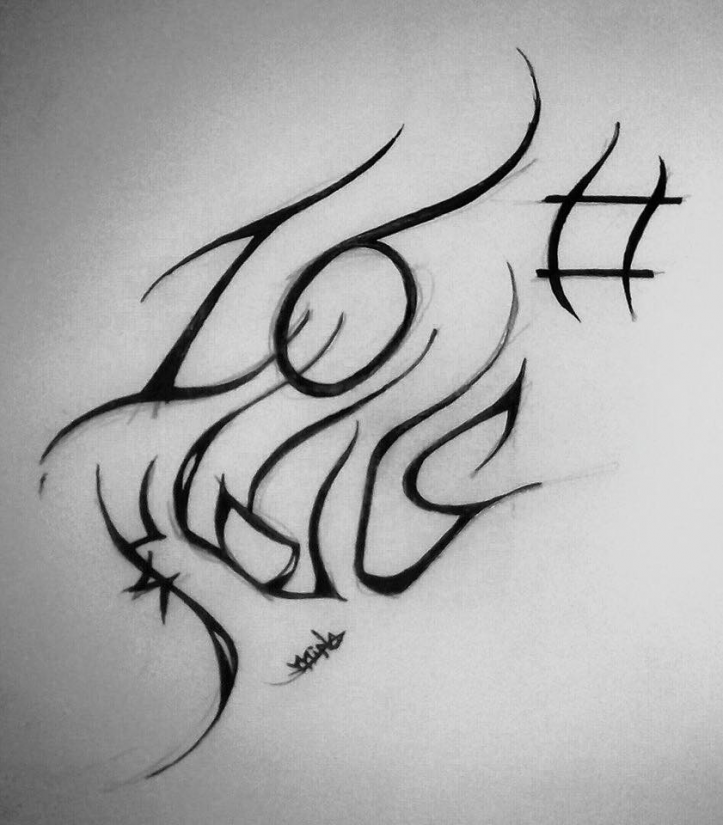

Flying 16 banners
Before performing his 16 bars, a rapper introduces himself and verbally confirms that he has “accepted the challenge” (ana ’abilt al-tahaddi). He then gives “shout outs,” enumerating the names of fellow rappers in his close network. After finishing the 16 bars, he declares his nominations for the next three (or more) rappers.
Rappers from all over Egypt began posting videos. Then from Morocco, Algeria, Jordan, Lebanon, Palestine, Syria, Saudi Arabia, as well as Arab rappers living abroad. Following the Flying 16’s instructions, rappers archive their videos alphabetically by stage name on the group’s Facebook page to create an organized entry “log.” Each video post displays the rapper’s name, country of origin/residence, and variations of the “Flying 16” hashtag in Arabic and English. The videos themselves are generally no more than several minutes in length.
Shahin al-Abqari, Egypt
Mirar, Jordan
Joining the Virtual Cipher
I started watching these videos, following the network of nominations from one rapper to the next, some of whom were close friends of mine, others I was hearing for the first time. In my mind, each new nomination signaled a virtual “passing of the mic” to the next rapper in the cipher. Each rapper introduced a unique approach to the task, responding to his or her challenger, building off a kind of virtual momentum. As I watched, I thought about the old Mafshakha gatherings on Thursday nights. While I don’t suggest the Flying 16 was meant to replace the Mafshakha, I intuitively wonder what happens when these communal hip hop dialogues, these creative spaces, move from the physical world of sidewalks and street corners to the virtual world of YouTube and Facebook. What does this virtualization add to the experience for Egyptian youth? What does it take away? And what specific problems, if any, does this online exchange pose for participants?
In thinking about these questions, I’d like to isolate a few aspects of this online video exchange that I find most interesting. The first point relates to the presentation of self.
Preparing the Non-Performance
Although both the Mafshakha ciphers and Flying 16 videos were filmed and uploaded online, the video component was a precondition only for the latter. The Mafshakha would have existed without its videos, which were used partly as propaganda, partly as a record of particular gatherings. The Flying 16, on the other hand, used the videos themselves as exchangeable utterances within the virtual cipher. With rappers performing directly into the camera lens for a hypothetical audience, Flying 16 videos come across as acutely self-conscious. More than face-to-face ciphering, the video medium affords the luxury of time and preparation. A rapper can carefully map out his performance in advance, record, and re-record as he sees fit.[7] With regard to the Flying 16, it’s worth considering how rappers precisely manage their own bodies and environments before the camera.
For Egyptian rappers, this management is important because it allows for the display of specific symbols that index authenticity in their communities. Ediz Omer Ozelkan (2016) recently contributed an article to “Bring the Noise” about rap ciphers in New York City. In it, he asserts that a rapper’s authenticity is “embodied” through particular “oratory exercises” and “apprenticeships” — in other words, through particular performances in his community. Likewise, each video in the Flying 16 Challenge amounts to an arrangement of signs, a performance of those traits that rappers think will earn them the most cultural capital in their community.
The “log” of Flying 16 videos tells us much about what Egyptian (and Arab) rappers prioritize in their communities. There are any number of visual signs to consider: video location (home, car, studio), rapper’s attire (hoodie, sports jersey, traditional robe), background (basketball court, calligraphic mural, Tupac poster). One’s appearance plays an important role in face-to-face ciphers like the Mafshakha where participants all come to a shared public location. But visual presentations in the Flying 16 videos are perhaps more significant because we see what rappers choose to emphasize in their performances when they have control of the environment. And critical to these presentations is the suggestion that the performance on screen is, in fact, not a performance at all.
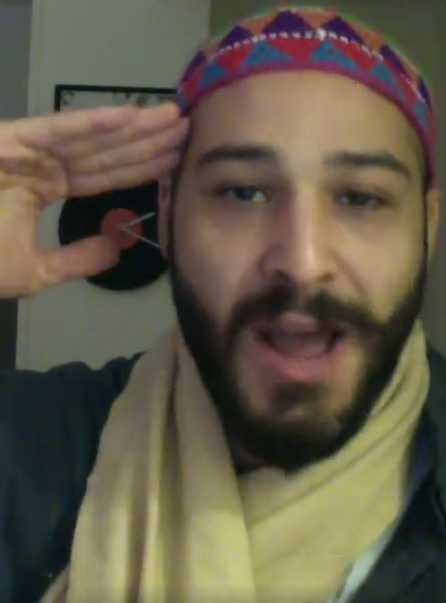
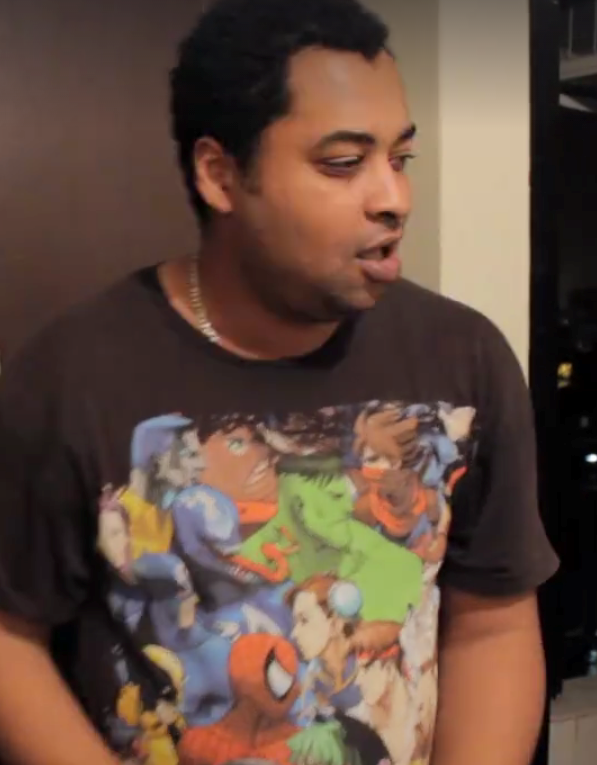
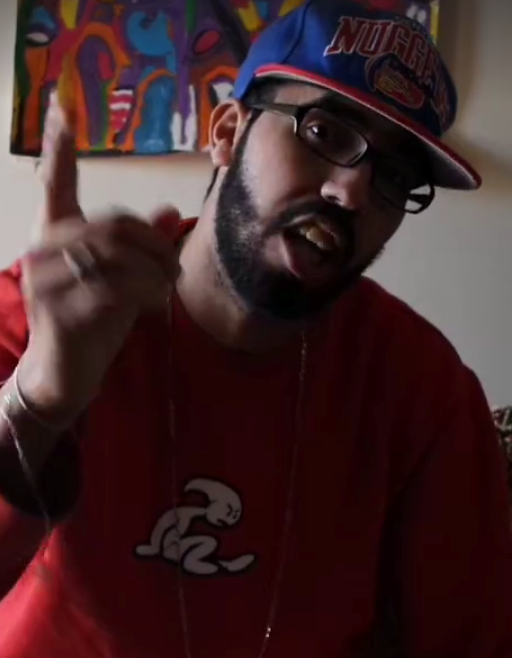
Flying 16 video submissions
The rapper who films in his car implies the ordinariness of the task. It’s so innate he can do it in transit. The cigarette dangling from another rapper’s lips suggests an air of nonchalance. Rather than drawing attention to the start of the performance, the event’s markedness is played down by the routine act of smoking. Likewise, the rapper who films wearing his prayer robes and skull cap seems to convey another attitude, one of spiritual grounding, a kind of moral authenticity.
Rappers also make claims to authenticity through their verbal performances. The rap lyrics themselves are perhaps the most obvious component of this. But consider also the “shout-outs” section of each Flying 16 video, which provides a space for rappers to position themselves within a particular hip hop lineage. Then there’s the palpable hip hop nationalism that emerges in online dialogues between rappers from different Arab countries (“Come to Saudi Arabia if you want to hear real rap,” “I’m shocked at the poor skills of Egyptian rappers,” etc.). Even the Flying 16’s mission statement was framed in national terms. In looking at claims of authenticity, this kind of verbal posturing must be considered in tandem with the calculated management of body and background.
Technology, Gender, and Veteran Status
The second point I want to consider is how these different “ciphers” both facilitated and limited who was able to participate. Video contributions for the Flying 16 necessitate access to a camera, computer, or phone with comparable capabilities. This is technology that some, but not all, Egyptian youth can obtain. Thus, the Flying 16 was not open to all rappers but rather those with access to the tools of production. The Mafshakha ciphers, on the other hand, required only that participants show up and join the circle. Mafshakha gatherings were, however, prohibitive to other groups of Egyptians.
While the Mafshakha welcomed participation from all rappers, female rappers did not answer this call. The Mafshakha remained almost exclusively male. In contrast, the Flying 16 receives many videos from female rappers in Egypt and abroad. Some of these are widely viewed. Doaa Badr Eldeen’s video from December 12, 2015 dwarfs most Flying 16 contributions with over 40,000 YouTube hits.
The Mafshakha was marked by clear power hierarchies that also affected participation. For instance, many attendees complained that the Mafshakha’s founder Afreet and other veteran rappers dominated the cipher space, leaving few opportunities for new rappers to test their skills. The virtual cipher affords lesser-known rappers the chance to post their videos without veteran rappers monopolizing the limelight. Of course, there is no guarantee that each video will be watched once it’s posted.

Flying 16's Doaa Badr Eldeen
Feeling Flow in the Cipher
My last point relates to the affective component of ciphering, also discussed by Ozelkan (2016) in his recent essay. In the cipher, both the rapper and his audience contribute to the formation of an energy that peaks at certain moments during the performance. This is usually a semi-mystical feeling of being transported to a different musical, emotional, or mental state. In the jazz scene, musicians often call this “flow” (Hytonen-Ng 2013). In classical Arabic art music, the term “tarab” refers to this sensation of musical ecstasy (Racy 2003). As Ozelkan notes, this unique energy in the rap cipher does not arise from a single source but a combination of performative, rhythmic, and lyrical elements together. American rappers often describe being “in the zone,” feeling a special connection with fellow performers, the audience, and the creative energy of the moment. For American cipher participants, this moment of being “in the zone” is what distinguishes the cipher from performances on a stage or recorded performances of rap music.[8] Rappers in Egypt suggested a similar distinction to me.
While watching the Flying 16 videos, I wondered if Arab rappers experienced some version of this energy through their online exchanges. Victor Turner talks about how rituals have the potential to produce “communitas,” a heightened sense of togetherness and belonging (Turner 1969). The Flying 16’s fixed process of getting nominated, performing, and rejoining the internet audience mirrors in many ways the ritual phases of separation, liminality, and aggregation. So if creating these videos does entail a ritual element, perhaps there is also the potential for a kind of communitas between rappers who participate in the virtual cipher.
Conclusion
My discussion of the Mafshakha and the Flying 16 shows that Egyptian rappers use multiple tactics to establish creative spaces for themselves. They adapt to local constraints and figure out new ways to accomplish their goals. In the case of the Flying 16, the virtual medium fostered fresh hip hop activity but also restricted this activity in specific ways. The Flying 16 craze exemplifies the interconnectedness of cultures today. The model of the Ice Bucket Challenge was adopted in Egypt’s Flying 16 Challenge, which eventually spread to other Arab countries where rappers produced videos that I watched at my home in the United States. These flows of information among networks of people are not unidirectional. They emanate out, bounce around, sometimes settle, and often return in different forms. Thinking about music flows in particular, what can we learn from research on virtual worlds of gaming and social networks? Can such online communities share experiences that generate communitas? And if so, how would this virtual communitas translate into real-world social relationships? I leave these questions unanswered, hoping they will open future dialogues for the exchange of ideas, just as the ideal cipher might do.
References
Hytonen-Ng, Elina. 2013. Experiencing ‘Flow’ in Jazz Performances. Abingdon, UK: Routledge.
Lee, Jooyoung. 2009. "Escaping Embarrassment: Face-work in the Rap Cipher." Social Psychology Quarterly 72(4):306-324.
Ozelkan, Ediz O. 2016. “Legendary Cyphers: The Pedagogy of Rhyme.” Ethnomusicology Review. Bring the Noise. http://ethnomusicologyreview.ucla.edu/content/legendary-cyphers-pedagogy-rhyme. Accessed September 25, 2016.
Racy, Ali Jihad. 2003. Making Music in the Arab World: The Culture and Artistry of Tarab. Cambridge: Cambridge University Press.
Turner, Victor W. 1969. The Ritual Process: Structure and Anti-structure. Chicago: Aldine.
Notes
[1] The Egyptian slang term "Mafshakha" has no equivalent in English, but Egyptian rappers use it to mean a kind of “battle zone” or “proving ground” for rap.
[2] To “cipher" (also spelled “cypher”) means to exchange lyrics with one or more rappers, usually in a circular formation, each rapper taking his turn and then “passing the mic” to the next rapper.
[3] I have discussed the Mafshakha at length in papers presented at the 2016 Mid-Atlantic Chapter of the Society for Ethnomusicology meeting (University of Virginia) and at Westminster University’s 2016 conference “Towards a Sociology of Popular Music in the Arab Region” in London, England.
[4] See, for example, the recent freestyle battle between rappers Atwa and Yousef Joker: https://www.youtube.com/watch?v=VxVJ3nyy5Qo
[5] Arab rappers use both the Arabic and English names to refer to the Flying 16 Challenge. The English translation is also used on the group’s Facebook page and banner.
[6] Arabic original at: https://www.facebook.com/Flyin16Challenge/about/?entry_point=page_nav_about_item&tab=page_info
[7] Interestingly, while American rap usually emphasizes “freestyle” (improvised) ciphering and stigmatizes pre-composed lyrics, this is not the case in Egyptian rap. For more on improvisation in rap ciphers, see Jooyoung Lee (2009).
[8] For more on how American rappers talk about the communal energy of cipher performances, see Kevin Fitzgerald’s classic documentary Freestyle: The Art of Rhyme (2000).
Biography
Nicholas Mangialardi is a doctoral student in the Department of Arabic and Islamic Studies at Georgetown University. He studies modern Arabic literature, poetry, and music and is interested in Egyptian tarab music. He plays the Arabic nay flute and has performed with Egyptian rap groups in Cairo and Alexandria. Nicholas also conducts research on hip hop culture in Egypt and has presented his work at conferences in the United States and abroad.





